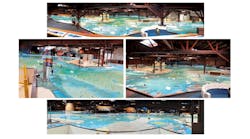If you get a chance, visit the Bay-Delta Model (see the figure) at 2100 Bridgeway in Sausalito, Calif., just across the San Francisco Bay bridge. Built by the U.S. Army Corps of Engineers, it’s a working hydraulic model of the San Francisco Bay and Sacramento-San Joaquin River Delta System. That comprises essentially all of the waterways around San Francisco and Silicon Valley.
The model was started in 1957 in response to the Reber Plan to fill in parts of San Francisco bay. Luckily the plan was scrapped, and the model has since been used for a wide range of projects. It’s still operational and open to the public, although no longer used for active research. Computers now do that job, as is the case for most simulations these days.
The Bay-Delta model measures over 320 by 400 feet and consists of a jigsaw puzzle of 286 five-ton concrete slabs. It’s built to a 1:1000 horizontal scale and 1:100 vertical scale mirroring ship channels, rivers, creeks, and canals. It includes major wharfs and bridges like the famous bay bridges. The time scale is 1:100, so it’s possible to watch the tides go in and out. Copper strips spread throughout simulate the proper hydraulic flow, because liquid movement is more efficient as the environment scales down.
The model did incorporate quite a bit of recording electronics. Plenty of applications still require this type of sensor information, especially when one considers “big data” analysis of distributed sensor networks providing real-time data. The main difference between now and then is many orders of compute magnitude. Sensor technology has also advanced significantly.
As an engineer myself, I can only say that I was blown away by the model’s scope. I’m glad I was able to see it up close.


